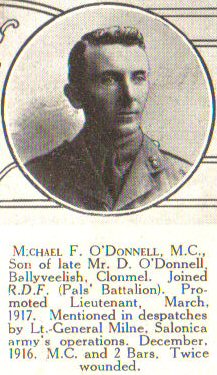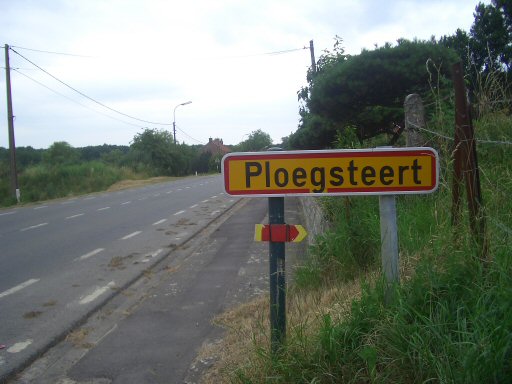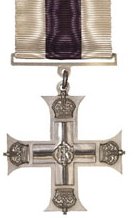Michael Francis O’Donnell was the only officer of the Royal Dublin Fusiliers ever to receive the Military Cross and two bars. Yet this brave man’s last resting place is an unmarked grave in Glasnevin Cemetery in Dublin.
O’Donnell was born on September 26 1886. At the outbreak of the First World War, he was a clerical officer with the Congested Districts Board of Ireland. He enlisted in the army in November 1914. He gave his address as 47 Irishtown, Clonmel, Co. Tipperary. He was posted as a Private in the “Pals”, the 7th (Service) Battalion of the “Dubs”. His regimental number 17392. On November 28 1914 he joined his new unit at the Curragh for training.
He was soon promoted to the rank of Lance-Sergeant and proceeded overseas with his unit in June 1915. He took part in the landings at Suvla Bay on August 7 1915. It was at this time, he was further promoted to the rank of Sergeant and saw continual service until December 1916 in places such as Gallipoli, Serbia and Salonika. He left Salonika in December 1916 and was mentioned in General Milne’s dispatches for that month. He returned home for a course in cadet school, before joining the 7th Officers Cadet Battalion at Moore Park, Fermoy, Co. Cork. After training he was gazetted as Second Lieutenant to the 11th Battalion of the Dublin Fusiliers on April 20 1917. In June he was send overseas to France attached to the 8th Battalion and was in action at the Third Battle of Ypres. It was there, on July 31 1917 he received his first wound, yet still remained at his post. Four days later, he was taken to a casualty clearing station near Habile where he received treatment for the next ten days. He returned to action at Friezenburg Ridge (Ypres) and was awarded a “Hickie Parchment” for operations in November 1917 for operations in the Bullecourt Sector. Due to heavy casualties, early in 1918, the 8th and 9th Battalions were amalgamated. Soon afterwards the casualties further increased, the officers and men of the 8th/9th Battalion were transferred to the 2nd Battalion.
He was granted leave March 20 1918 and arrived at Le Harve on March 21 to sail to England. However, the ship could not sail due to the German offensive and all leave was cancelled. He then had to return to the front, and was attached to Y Company of the 1st Battalion. On April 21 with O’Donnell leading, the Company took over the village of Beausingham from a company of the 2nd Battalion Irish Guards. The “Micks” had recently come under gas attack. During the handover, O’Donnell spent some time with the famous photographer Father Brown DSO, who was Chaplain to the Irish Guards. They spoke about “the death of the heroic Rev. W. Doyle MC who gave his life at Friezenburgh”. Willie Doyle had been Chaplain to the 8th Battalion of the Dubs.
The trenches taken over by Y Company were only three feet deep. Despite further gas attacks, headquarters would not allow the “Dubs” to make the trenches deeper or wider. They maintained that the appearance of freshly dug soil would betray the Company’s exact position. Needless to say, O’Donnell was not happy with this order.
In July, O’Donnell was sent on a five week course at Wisques (near St. Omer) with “a good many worn-out officers after the March Offensive”. The state of the other officers, perhaps, explains how he won competitions there in welterweight boxing and recreational training. He then proceeded to Hazebrouck, where officers “who had a rough time in the line were resting”. Unfortunately, there was not much opportunity for rest, as half an hour after his arrival (at 12:50 am) he was awoken with the news that Captain Alexander was badly gassed and he was to take over his platoon. A horse was provided for him to ride to Strazeele, with a guide, who “did not even know where the Battalion Headquarters were!”. Despite the gas shells raining down, O’Donnell dismissed the guide who “was left to wander around Strazeele”. At 2:15am, he finally located Capt. Maguire MC (who was the adjutant). O’Donnell, must have been exhausted by this stage, was told to locate and report to Lieutenant Cassidy. At daybreak, he finally found him with Second Lieutenant Lennon, who “were both very badly shaken from the Bosch shelling”.
While in Strazeele, on August 26 1918, O’Donnell was offered the position of Assistant Adjutant to the Battalion, by Colonel Moore DSO. O’Donnell declined this position as he “preferred being with my company”. Moore did not force the issue, and instead appointed Lieutenant Strange to the position. Two days later, his Company were assigned to a raid, in which O’Donnell and 2nd Lieutenant Lennon participated. Each had 25 men and were told to take three farmhouses held by a German officer and about 35 men. After the British barrage finished, the farmhouse was attacked. O’Donnell’s men were on the left and Lennon on the right. However, the Germans had abandoned the house. Despite the absence of any enemy, 2nd Lieutenant Lennon and on or two of his men were wounded as they got too close to the British barrage.
O’Donnell and the Battalion were ordered to La Romarin on September 2 1918, and were ordered to take Ploegsteert the following day “at all costs” (It is not clear if this order refers to human life or exertion!). The Dubs formed the right side of the attack, with W and X Companies leading and O’Donnell’s Y Company providing a defensive flank. The attack started shortly after dawn. They had not proceeded far before the Germans started trench mortaring. Severe casualties were suffered and the advance ground to a halt at 8:30am, about 900 yards from Ploegsteert. O’Donnell then decided to go forward to the leading Company Commander who was sending back messages for reinforcements. En route, he captured two German machine guns, one heavy and one light. In a farmyard on the main road to Plopegsteert, the Company Commander requested O’Donnell to go to the assistance of an advanced platoon of Y Company commanded by MJ McNulty, who had previously lost a portion of thumb, and a couple of fingers. When McNulty saw O’Donnell, he shouted, despite a throat wound “Mick, are there any stretcher bearers there?”. As O’Donnell and his runner, Private Coffey, raced towards McNulty, they saw him fall. O’Donnell was shocked to discover that “the poor fellow’s life was slowly ebbing, and was bleeding profusely”. On kneeling over him, he asked McNulty if there was any message that he wished to send home. He was unable to make any reply, and never spoke. At this point, they were under heavy machine gun fire and Coffey was wounded in the wrist.
There were only five men left in McNulty’s platoon, whom O’Donnell took command of. They took cover in a drain, which was five foot deep, containing about 18 inches of water. At 3pm they received a message that a British barrage was to be expected and Plopegseert was to be taken under this creeping barrage. As they advanced they discovered “the Bosch had very thick wire erected” and that “machine guns seemed to spring up everywhere”. They hacked their way through the wire and the “enemy surrendered rather too willingly”. The ones who did not surrender “bolted for their own lines and were nice targets for our men”. Plopegseert was consolidated that night and they were relieved by the Royal Fusiliers. O’Donnell had also captured another 4 guns (new field guns), which along with the 2 captured earlier on, totalled 6. He also captured several trench mortars.
Despite the success, the cost was high, casualties were heavy, four officers (1 killed) and about 250 rank and file. In addition, 185 Germans (including officers) were taken prisoner. The battalion were still complimented for their performance, and the Brigadier, Divisional Commander, Corps Commander and General Plume took the salute from the Battalion. The Battalion was also decorated with 4 MCs, 2 DCMs and 41 MMs. One of these Military Crosses was awarded to O’Donnell.
The citation reads:
“For conspicuous gallantry during an attack. Owing to casualties, he assumed command of 2 platoons, and with greatly reduced numbers, rushed a strong point, capturing an officer and six men and a machine gun. He next, from an advantageous point, causing heavy casualties with his Lewis guns on the retreating enemy, and, pushing on, he captured two field guns, one trench mortar and ten prisoners. From first to last, he set a splendid courage and leadership”.
The Battalion were moved to the Brandhoek area and next saw action on September 29 at Ypres. During this engagement O’Donnell was also Acting Transport Officer, as the TO was on leave. The battalion reached Cheuvelt, before they were withdrawn for rest. On October 13 1918, they were moved by light railway, to Ledgehem Railway Station. The Battalion advanced with Z Company on the left, Y Company (still under the command of O’Donnell) on the right with X and W companies behind. The advance started, under a heavy smoke barrage and quickly took their objective about 2500 yards east of Ledgehem. Unfortunately Colonel Moore was killed and the Battalion came under the command of Major Rigg. For this action he received a bar to his Military Cross. The citation reads:
“In the operations at Ledgeham on October 14th 1918, he showed marked gallantry and powers of leadership. On reaching the first objective in face of heavy fire he succeeded in working round to the flank of one machine gun, which was forced to retire from a commanding position from which it had been causing casualties. His example and coolness had a most inspiring effect on all ranks”.
As a result they were allowed to rest from October 14 until October 18. The Germans were retreating quickly and it was intended not to give them any rest. Therefore, from October 19 onwards they were chasing the Germans. At three o’clock on the afternoon of October 20, they met German machine gun fire from the right. They managed to dislodge two machine guns, which had caused many casualties. Just as the British barrage went down, O’Donnell was severely wounded in the shoulder and left thigh. He sent for Lieutenant Scott and handed over command of his company. O’Donnell received his second bar to his Military Cross (his third MC) and the official citation was:
“At St. Louis, in the Courtrai Sector, on October 20th 1918, his company was held up by machine gun fire. He made a personal reconnaissance under severe machine gun fire, and then led on and took the enemy position that was holding up the advance of the battalion. His marked courage and leadership were the means of enabling the battalion to advance”.
He received the Military Cross and 2 bars from King George V at Buckingham Palace on March 19 1919. He must have been proud of these awards as a letter relating to a piece in The Times illustrates “I beg to point out that the letter ‘MC’ should be added (to my name), considering the fact that I have been awarded the Military Cross and two bars” (sic). This was to be the pinnacle, as well as the end of his career. A medical examination was carried out and the report was as follows:
i. Left Thigh: a wound 10″ long beginning 2½” below Poupart’s ligament. A wound 6½” long in postero-external surface mid thigh. Stitches removed 8 November 1918.
ii. Right Shoulder: extensive wound involving muscles, 4½” long extending from above clavicle, across shoulder towards spine and ending 1½” from latter. Wound was septic on arrival in England and stitches had to be removed. This wound still causes limitation of movement of shoulder.
iii. Left leg: small wound.
iv. Right thigh: small wound.
v. Left arm: small wound 2″ above elbow in under side.
Collectively these wounds are equivalent to a very severe injury. (sic)
As a consequence of these wounds, he was invalided from the Army on July 27 1919, with the rank of Lieutenant. This must have been a bone of contention to O’Donnell, as a 1932 letter from O’Donnell to the War Office indicates, “I have been deprived for some inexplicable reason, of my rank of Captain, to which I was promoted at Ypres on October 11 1918, by my commanding officer Colonel Moore DSO”. Unfortunately, Colonel Moore DSO was killed in action on October 14 1918, without a chance to formalise O’Donnell’s promotion.
Michael Francis O’Donnell died at his home in Leinster Square, Dublin, on December 27 1958. In his will, after the payment of debts, everything was left to the Passionist Community in Mount Argus, Dublin. He was buried in a totally unmarked grave in Glasnevin Cemetery (Grave Number J.L.188½). Hopefully, sometime in the future, a benevolent society will make a contribution to provide a suitable memorial on the grave of this brave Irish soldier.
Sources:
Public Records Office, File Number W95/2301
Neils Blue Caps
Irish Times
Glasnevin Cemetery







